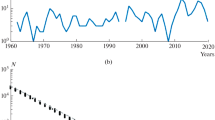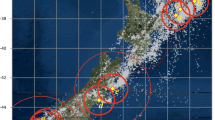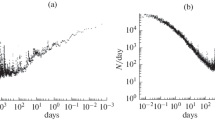Abstract
Previously, we predicted and then observed in practice the property of aftershocks which consists in the statistically regular clustering of events in time during the first hours after the main shock. The characteristic quasi-period of clustering is three hours. This property is associated with the cumulative action of the surface waves converging to the epicenter, whereas the quasi-period is mainly determined by the time delay of the round-the-world seismic echo. The quasi-period varies from case to case. In the attempt to find the cause of this variability, we have statistically explored the probable dependence of quasi-period on the magnitude of the main shock. In this paper, we present the corresponding result of analyzing global seismicity from the USGS/NEIC earthquake catalog. We succeeded in finding a significant reduction in the quasiperiod of the strong earthquakes clustering with growth in the magnitude of the main shock. We suggest the interpretation of this regularity from the standpoint of the phenomenological theory of explosive instability. It is noted that the phenomenon of explosive instability is fairly common in the geophysical media. The examples of explosive instability in the radiation belt and magnetospheric tail are presented. The search for the parallels in the evolution of explosive instability in the lithosphere and magnetosphere of the Earth will enrich both the physics of the earthquakes and physics of the magnetospheric pulsations.
Similar content being viewed by others
References
Adushkin, V.V. and Turuntaev, S.B., Tekhnogennye protsessy v zemnoi kore (opasnosti i katastrofy) (Anthropogenic Processes in the Earth’s Crust: Hazards and Catastrophes), Moscow: INEK, 2005.
Bath, M., Lateral inhomogeneities of the upper mantle, Tectonophysics, 1965, vol. 2, pp. 483–514.
Bolt, B., Earthquakes: A Primer, San Francisco: Freeman, 1978.
Buchachenko, A.L., Magnetoplasticity and the physics of earthquakes. Can a catastrophe be prevented? Phys.-Usp., 2014, vol. 57, no. 1, pp. 92–98.
Gufel’d, I.L. and Novoselov, O.N., Seismicheskii protsess v zone subduktsii (Seismic Process in Subduction Zone), Moscow: MGUL, 2014.
Guglielmi, A.V. and Zotov, O.D., On the near-hourly hidden periodicity of earthquakes, Izv., Phys. Solid Earth, 2013, vol. 49, no. 1, pp. 1–8.
Guglielmi, A.V. and Potapov, A.S., On permanent and sporadic oscillations of the magnetosphere, Cornell Univ. Libr. arXiv: arXiv:1408.2916 [physics.space-ph]. 13 Aug 2014.
Guglielmi, A.V., Zotov, O.D., and Zavyalov, A.D., The aftershock dynamics of the Sumatra-Andaman earthquake, Izv., Phys. Solid Earth, 2014, vol. 50, no. 1, pp. 64–72.
Guglielmi, A.V., Foreshocks and aftershocks of strong earthquakes in the light of catastrophe theory, Phys.-Usp., 2015a, vol. 58, no. 4, pp. 384–397.
Guglielmi, A.V., On self-excited oscillations of the Earth, Izv., Phys. Solid Earth, 2015b, vol. 51, no. 6, pp. 920–923.
Guglielmi, A.V., Three unsolved problems in physics of Pc1 magnetospheric waves, Geofiz. Issled., 2015c, vol. 16, no. 3, pp. 63–72.
Guglielmi, A., Lavrov, I., Sobisevich, A., Zavyalov, A., and Zotov, O., On the foreshocks of strong earthquakes, 26th IUGG General Assembly, Prague, Czech Republic, June 22–July 2, 2015, poster presentation.
Kasahara, K., Earthquake Mechanics, Cambridge: Cambridge Univ. Press, 1981.
Kuksenko, V.S., Makhmudov, Kh.F., Manzhikov, V.A., Sultonov, U., and Rustamova, M.Z., Change in structure of natural heterogeneous materials under the deformation, J. Min. Sci., 2009, vol. 45, no. 4, pp. 355–358.
Kuksenko, V.S., Makhmudov, Kh.F., and Manzhikov, B.Ts., Damage accumulation model for solids and the catastrophy prediction for large-scale objects, J. Min. Sci., 2010, vol. 46, no. 4, pp. 384–393.
Lutikov, A.I. and Rodina, S.N., Temporal and power parameters of aftershock process of the Kuriles-Kamchatka earthquakes, Geofiz. Issled., 2013, vol. 14, no. 4, pp. 23–45.
Lyusina, A.V. and Smirnov, V.B., Time grouping of the aftershock sequences by the example of the Koalinga (May 2, 1983) and Idaho (October 28, 1983) earthquakes, Izv. Akad. Nauk SSSR, Fiz. Zemli, 1993, no. 8, pp. 9–14.
Makhmudov, Kh.F., Menzhulin, M.G., Zakharyan, M.V., Sultonov, U., and Abdurakhmanov, Z.M., Diagnostics of the loss of stability of loaded constructions and the development of the sites of breakdown during the action of seismic explosion and air shock waves, J. Tech. Phys., 2015, vol. 60, no. 11, pp. 1651–1657.
Mikhailov, A.S. and Uporov, I.V., Critical phenomena in media with breeding, decay, and diffusion, Phys.-Usp., 1984, vol. 27, no. 9, pp. 695–714.
Mogi, K., Earthquake Prediction, Tokyo: Academic Press, 1985.
Nishida, A., Geomagnetic Diagnosis of the Magnetosphere, New York: Springer, 1978.
Omori, F., On the aftershocks of earthquake, J. Coll. Sci. Imp. Univ. Tokyo, 1894, vol. 7, pp. 111–200.
Reid, H.F., The elastic-rebound theory of earthquakes, Bull. Dep. Geol. Univ. Calif. 1911, vol. 6, no. 19, pp. 413–444.
Smirnov, V.B. and Ponomarev, A.V., Seismic regime relaxation properties from in situ and laboratory data, Izv., Phys. Solid Earth, 2004, vol. 40, no. 10, pp. 807–816.
Sobolev, G.A., Osnovy prognoza zemletryasenii (Introduction to the Prediction of Earthquakes), Moscow: Nauka, 1993.
Sobolev, G.A. and Ponomarev, A.V., Fizika zemletryasenii i predvestniki (Physics of the Earthquakes and Precursors), Moscow: Nauka, 2003.
Tarasov, B., Superbrittle failure regime of rocks at conventional triaxial compression, in True Triaxial Testing of Rocks, Geomechanics Research Series, vol. 4, Leiden, the Netherlands: Taylor and Francis, 2013, pp. 343–350.
Utsu, T., A statistical study on the occurrence of aftershocks, Geophys. Mag., 1961, vol. 30, pp. 521–605.
Vinogradova, M.B., Rudenko, O.V., and Sukhorukov, A.P., Teoriya voln (Theory of Waves), Moscow: Nauka, 1979.
Weimer, S. and Katsumata K., Seismicity parameters in aftershock zones, J. Geophys. Res., 1999, vol. 104, no. B6, pp. 13135–13151.
Zavyalov, A.D., From the kinetic theory of strength and fracture concentration criterion to the seismogenic fracture density and earthquake forecasting, Phys. Solid State, 2005a, vol. 47, no. 6, pp. 1034–1041.
Zavyalov, A.D., The earthquake offshore Sumatra, Priroda (Moscow, Russ. Fed.), 2005b, no. 5, pp. 29–35.
Zavyalov, A.D., Guglielmi, A.V., and Zotov, O.D., The aftershocks of the strong earthquakes: new properties, 10-ya mezhdunarodnaya seismologicheskaya shkola “Sovremennye metody obrabotki i interpretatsii seismologicheskikh dannykh” (The 10th Int. Seismological School Modern Methods for Processing and Interpretation of Seismological Data), Azerbaijan, Sept. 14-18, 2015, Obninsk, 2015a, p. 378.
Zavyalov, A.D., Zotov, O.D., and Guglielmi, A.V., On new properties of aftershock’s flow of the strong earthquake, 26th IUGG General Assembly, Prague, Czech Republic, June 22–July 2, 2015b.
Zavyalov, A.D., Zotov, O.D., and Guglielmi, A.V., On the new properties of the aftershock flow from strong earthquakes, 3-ya nauchnaya konferentsiya “Triggernye effekty v geosistemakh,” tezisy dokladov (Abstr. 3rd Conf. “Triggered Effects in Geosystems”), Moscow, June 16-19, 2015, Moscow: IDG RAN, 2015c, pp. 33–34.
Zavyalov A.D., Zotov O.D., Guglielmi A.V. On new properties of aftershock’s flow of the strong earthquakes, Extended Abstracts 2nd Int. Workshop on Tethyan Orogenesis and Metallogeny in Asia (IWTOMA) and Silk Road Higher Education Cooperation Forum, Wuhan, China, October 16–21, 2015, Ma, Changqian, Robinson, P.T., Mason, R., and He, Yunlong, Eds., 2016, pp. 185–186.
Zhurkov, S.N., Kinetic concept of the strength of solids, Int. J. Fracture Mech., 1965, vol. 1, no. 4, pp. 311–323.
Zhurkov, S.N., Kinetic concept of the strength of solids, Vestn. Akad. Nauk SSSR, 1968, no. 3, pp. 46–52.
Zotov, O.D. and Guglielmi, A.V., Problems of synchronism of electromagnetic and seismic events in the Magnetosphere–Technosphere–Lithosphere dynamic system, Sol.-Zem. Fiz., 2010, no. 16, pp. 19–25.
Author information
Authors and Affiliations
Corresponding author
Additional information
Original Russian Text © A.V. Guglielmi, A.D. Zavyalov, O.D. Zotov, I.P. Lavrov, 2017, published in Fizika Zemli, 2017, No. 1, pp. 12–19.
Rights and permissions
About this article
Cite this article
Guglielmi, A.V., Zavyalov, A.D., Zotov, O.D. et al. Dependence of the aftershock flow on the main shock magnitude. Izv., Phys. Solid Earth 53, 10–17 (2017). https://doi.org/10.1134/S1069351317010086
Received:
Published:
Issue Date:
DOI: https://doi.org/10.1134/S1069351317010086




